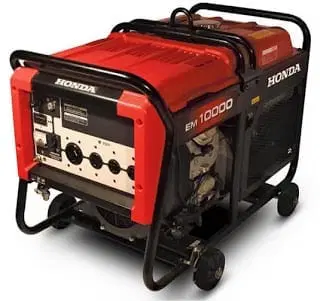To ensure that your electricity generator runs efficiently, make sure you follow the proper technique for turning it on. This article will show you how to start a generator. For exact instructions on how to start your generator, consult your owner’s manual.
Step 1: Take Generator to a Well Ventilated Environment
Make sure your generator is outside the house, in a well-ventilated, weather-protected location. With reports of individuals dying from carbon monoxide suffocation in Nigeria every week, this measure must be taken. Also, make sure the generator isn’t too close to a wall or anything flammable.
Step 2: Check oil & fuel levels
Before moving on to the following stage, make sure the gasoline in the tank is at least 15% of the generator’s capacity. The oil level in the crankcase must also be above the minimum (gauge level).
Step 3: Disconnect all Load from Generator
Make sure the generator is disconnected from the load (appliances). You can accomplish this by setting the transfer switch to neutral or leaving the grid connected. You can also simply switch off the generator.
Remove the connecting cable from the generator receptacle to accomplish this. Never start your power generator with appliances connected; this might damage the generator, especially if you have appliances that require a lot of starting electricity, such as air conditioners and refrigerators.
Step 4: Turn on the Fuel Valve
This will enable fuel to flow into the carburetor in readiness for the generator start and continuous operation.
Step 5: Move choke to closed position
The choke rod is identified in the manual. By moving the rod from left to right, the choke is normally closed. You can remove the choke on various generators. You can also study your generator’s user handbook or ask your dealer for instructions on how to choke your generator.
Step 6: Turn on Engine Switch
Generators with rope and grip (recoil start) often include an engine switch that must be turned on before the generator can be started.
Because the process of starting the generator with a key also turns on the engine, power generators with key start do not come with a separate engine switch.
If a key start generator also has a rope or grip start, you can start it with the key by rotating it clockwise until it reaches the 12 o’ clock position.
Step 7: Start Engine & Generator
The majority of generators use one of two starting procedures. The recoil starter (rope and grip) is used by some, whereas the key starter is used by others. Only a few have both options. There are also new options that allow you to begin with merely a start button.
Pull the rope lightly (slowly) until you feel resistance, then apply a fast pull to start a generator using a recoil starter.
Turn the key clockwise to start a generator with a key starter. Using the key for more than 5 seconds at a time is not recommended. Allow enough time for the starter to cool before trying again if the key fails to start. Step 8 should be completed once the generator has started.
Step 8: Move Choke to Open Position
Now is the time to return the choke to its resting position. Most generators can be done by sliding the rod from left to right or by putting the choke in. Once the generator has started, this should be done.
Step 9: Operate Generator at No Load for Awhile
This step is only required if the generator is being started for the first time in a day. The duration might range from one minute to five minutes. This will guarantee that the generator is in good working order to handle the load.
This step should be skipped for subsequent starts. Never start a generator with a load attached. Always run for at least 10 seconds with no load.
Step 10: Connect Load
Your load should now be connected. This is accomplished by switching the transfer switch from neutral to generator or by attaching the connection cable to the panel receptacle.
A generator is designed to run for a set amount of time, usually 4.5 hours or more. Consult your generator’s user manual to determine how long it can run continuously.
Running your generator for more than the recommended amount of hours can cause damage to it. Read our tutorial on How to Turn Off a Generator when you’re ready to turn off your generator.
Conclusion
This article is not a replacement for your generator’s owner’s manual. Be less confident, however, that every effort has been made to ensure the accuracy of the information supplied. To guarantee that your generator runs efficiently, always start it the appropriate manner.
